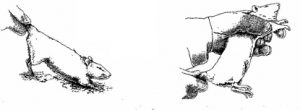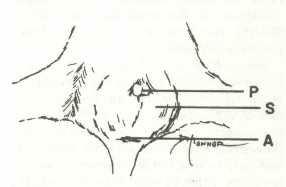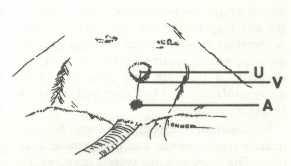The common lab rat was developed from the wild brown Norway rat. Outbred strains are used more commonly today in laboratories than inbred strains. Some common outbred strains are Wistar (albino rat), Sprague-Dawley (albino rat- faster growing than the Wistar) and Long-Evans (hooded rat -smaller than the Wister or Sprague-Dawley). The Fisher 344 and Lewis strains are two common inbred strains used in research. Rats can develop naturally occurring diseases such as diabetes and hypertension which makes them valuable in the study of those diseases as they apply to humans and they are also frequently used in behavior and nutritional studies, toxicology studies or drug and longevity studies.
Identification
More permanent systems of identifying rats include ear notching and tattooing. Stains and dyes can be used for temporary identification. Cage cards should be used on the cages.
Handling and Restraint
For brief periods of handling or transferring to another cage the rat can be picked up by the base of the tail. Serious injury can result to the rat if picked up by the tip of the tail since the tail skin may pull off. Another method involves catching the rat by the tail and then putting the thumb and forefinger of the other hand over the animal’s back and pushing the front legs toward the animals head. The tail or hindquarters may be restrained by the other hand. (Figure 3) Rats can also be wrapped in a towel or placed in a commercial plastic restraint device. Rats respond positively to gentle handling and become more relaxed the more they are handled.
Figure 3.

Physiological Data
Body temperature: 96.6° -99.5° F (35.9° -37.5° C)
Heart rate: 250 to 600 per minute
Respiration rate: 66-144 per minute
Weight: Adult male, 300-500 grams: adult female, 200-400 grams; newborn, 5 grams
Water consumption: 24-60 mls per day, or 10-12 ml per 100 grams body weight daily
Food Consumption: 15-30 grams per day, or 5-6 grams per 100 grams body weight
Feces: Firm, dark brown, elongated mass with rounded ends.
Urine: Clear and yellow
Life span: 2.5-3.5 years
Sex and Breeding
The anogenital distance is about twice as great in the male as in the female. (Figure 4) In adult male rats the testes protrude prominently from beneath the tail. Rats may be bred in monogamous pairs where the male always remains with the female or is housed with her for a suitable period of time usually a week. Polygamous (harem) systems can also be used where several females are placed together with one male and the female can be removed one week prior to parturition. Females are polyestrous and have a postpartum estrus. The come into heat and are receptive to males within 24 hours of parturition. The young are born pink-skinned and hairless and helpless.
Figure 4. External genitalia of male rat. P= tip External genitalia of female rat. U= of Penis; S= scrotal sac; A= anus urethral orifice; V= vaginal orifice; A= anus.


Sexual maturity: 65-110 days
Estrous cycle: 4-5 days
Gestation: 20-22 days
Litter size: 7-11
Cannibalism: Usually will not happen unless young are unhealthy
Weaning: 21 days
Behavior
Rats normally sit on all four limbs on the cage floor. A rat that is hunched over is an early sign of poor health. Healthy rats keep themselves groomed and cleaned. Rats are nocturnal creatures. Group housed males and females rarely fight. Male rats are usually easier to handle than females. Rats are usually quiet unless they are handled roughly, in which case they may squeal. The tears and saliva of rats contain a substance called porphyrin which is red or reddish-brown in color. This can sometimes be seen around the nose and eyes and is especially noticeable on white animals. In older animals all of the fur may appear reddish in color due to the animal licking itself while grooming. Excessive accumulation of porphyrin around the eyes, nose or on the front legs can be a sign of illness.
Husbandry and Diet
Rats can be housed in shoebox cages that provide a direct contact bedding. Rats can also be housed in wire-bottom cages if scientifically justified. Rat shoebox cages should be changed once or twice a week depending on the number of animals inside. Accessories should be sanitized at least once a week. Wire-bottom cages should be sanitized every two weeks and pans cleaned two to three times a week and sanitized every two weeks. Shelving should be sanitized every two weeks.
The temperature of the animal room should be between 64 and 79 degrees Fahrenheit. Humidity should be 45 to 55 % to prevent ringtail. Ringtail may appear as raised concentric ridges on the tail when the relative humidity falls below 20%. The tail can become necrotic and fall off. Twelve to fourteen hours of light daily are desirable. Rats have very sensitive hearing so marked changes of the auditory level in the animal rooms should be avoided since they will have an effect on the animal’s bodily functions and behavior.
The front incisor teeth of the rat grow continuously throughout life. The hard chow that they are fed usually keeps the teeth worn down to normal size. Sometimes, the teeth may become overgrown and interfere with the animal’s ability to eat. This may present as teeth protruding from the mouth or the rat may show signs of decreased food intake and loss of weight. Chipping off the extra length with scissors or small wire cutters cure the problem temporarily. Rats are commonly fed and watered ad libitum. They are fed a laboratory quality rodent chow. The average diet contains the following: 18 to 24 % protein, 4 to 7 % fat, and 60 to 75 % carbohydrate.